Edmonton Police Service
The Edmonton Police Service (EPS) is the municipal police force for the City of Edmonton, Alberta, Canada. The current chief of the EPS is Dale McFee.
| Edmonton Police Service | |
|---|---|
 | |
| Abbreviation | EPS |
| Motto | Integrity • Courage • Community |
| Agency overview | |
| Formed | June 20, 1892 |
| Annual budget | $362 million (2019)[1] |
| Size | 685.25 square kilometres (264.58 sq mi)[2] |
| Population | 932,546 (2016)[2] |
| Legal jurisdiction | Municipal |
| Headquarters | 9620 103A Avenue Edmonton, Alberta, Canada T5H 0H7 |
| Sworn members | ~1,780 |
| Unsworn members | ~720 |
| Elected officer responsible |
|
| Agency executive |
|
| Facilities | |
| Stations | 15 |
| Website | |
| www | |
The service has three deputy chiefs – two sworn members and a civilian member. Chad Tawfik is responsible for the Corporate Services Bureau, Kevin Brezinski runs the Intelligence and Investigations Bureau, and Darren Derko heads the community policing bureau.[3]
Operations
The EPS is divided into Six bureaus:
- Community Policing Bureaus
- North Bureau & South Bureau
- Intelligence and Investigations Bureau
- Corporate Services Bureau
- Community Safety and Well-Being Bureau
- Innovation and Technology Bureau
Patrol
The city is divided into divisions for general patrol purposes:
- Northeast
- Northwest
- Downtown
- West
- Southwest
- Southeast
Each division is separated into four smaller districts to allow for better deployment of resources. The majority of police officers of the Edmonton Police Service serve within the community policing bureau as patrol constables, sergeants, detectives, or staff sergeants.
Officers of the Edmonton Police Service have the highest first year constable salaries in Canada at a minimum of $67,414.00 per annum (or about $32.28 an hour), EPS officers who work a shift where half or more of that shift falls between the hours of 4:00 p.m. and midnight receive an extra $1.10 an hour. EPS officers who work a shift where half or more of that shift falls between the hours of midnight and 8:00 a.m. receive an extra $1.20 an hour, increasing the minimum hourly rate for first year constables to $30.47 or about $63,621.00 per annum. Special event policing pays $93.89 an hour. Sergeants and detectives are paid a minimum $120,742.00 per annum, or about $57.82 an hour, and staff sergeants are paid a minimum $132,816.00 per annum, or about $63.60 an hour.[4]
Criminal investigations
Within the specialized community support bureau – criminal investigations division, the major crimes branch is divided into economic crimes, homicide and robbery. These areas are primarily made up of detectives and staff sergeants. The serious crimes area deals with sexual assault, child protection, and vice. These areas are also made up of detectives and staff sergeants. The Edmonton Police Service is also a member of the Alberta Law Enforcement Response Teams.
Guard of Honour and Historical Unit
The EPS Guard of Honour and Historical Unit is a special unit of the EPS composed of dedicated policemen who serve as professional ambassadors of the City of Edmonton to the public. It was introduced to the EPS in 1998, and has provided consistent protocol demonstrations at events such as:
- Remembrance Day parade
- EPS Awards Day
- EPS graduations
- Dignitary escorts
- Police officer funerals and memorials
The historical unit ceremonially represents the EPS at its various historical events. The uniform that is worn is a replica of the EPS uniform worn in the early 1900s.[5]
Pipe Band

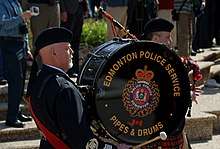
The Edmonton Police Service Pipe Band was formed in 1914, although it was immediately dissolved at the start of the First World War, with its musicians being transferred to the Canadian Army to join Princess Patricia's Canadian Light Infantry and lead the regiment into battle. Members of the pipe band also served as stretcher bearers for the regiment for the duration of the war during the war. The Pipes and Drums of the EPS were re-founded in 1961, and as a result of this historical arrangement, the band has grown closer with the PPCLI unlike other police bands. The band was first invited to play at the PPCLI beating retreat ceremony in 1964 and then at the regimental trooping of the colour in 1967.[6] Today, it is the only non-military civilian band within the Commonwealth to wear the badges of three Canadian regiments, with one of these being the PPCLI. While serving as a public relations tool for the EPS, it still performs alongside the regiment today during public events in Edmonton.[7] The band also has connections with the Canadian Airborne Regiment and The Loyal Edmonton Regiment.[8]
Equipment and vehicle fleet
Road vehicles
The Edmonton Police Service uses the D&R RDS 16 siren in the majority of their fleet that is also equipped with the howler brand. Each marked vehicle has the Whelen Legacy lightbar, (excluding the Crown Victorias and Ford Taurus that are equipped with LED X light bars and some Code 3 sirens.
- Ford Police Interceptor Utility (majority of fleet)[9]
- Ford Crown Victoria (being phased out gradually)
- Ford Taurus interceptor
- Chevrolet Tahoe
- Dodge Charger
- Dodge Ram
- Ford F 150 Pickup truck
- Ford Transit Van
Aircraft
- Eurocopter EC120 Colibri C-FEPS (retired in 2018)[10]
- Eurocopter EC120 Colibri C-GEPS (backup to C-EPU starting in 2018)[11]
- Airbus H125 C-FEPU (entered service in 2018)
Rank insignia
| Ranks | Chief of police | Deputy chief | Superintendent | Inspector | Corps sergeant major | Staff sergeant | Sergeant | Senior constable | Constable |
|---|---|---|---|---|---|---|---|---|---|
| Insignia | 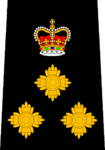 |
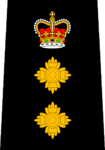 |
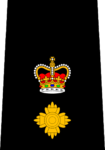 |
 |
No insignia available |  |
 |
 |
No insignia |
History
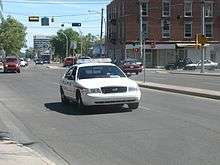
Edmonton's police date back to 1892, well before the founding of the province.
On July 27, 1892, P.D. Campbell was the first police officer hired by the town of Edmonton. Aside from dealing with law enforcement issues, Campbell was also Edmonton's health and licence inspector.[12]
In 1911, Alex Decoteau was hired by the Edmonton Police Department, becoming the first full-blooded aboriginal to be hired by a police department in Canada.[13]
On October 1, 1912, Annie May Jackson was hired on as Edmonton's first female police officer, winning out over a field of 47 applicants.[14]
An airplane was used to pursue a criminal in 1919, which was the first time a Canadian police service used this tactic.
Policing changes
During the sixth decade of policing, from 1942 to 1952, the department continued to grow.
In 1943, the Neighbourhood Police Force was seen policing Edmonton's streets. An Edmonton police officer was paired up with an American military police officer to patrol because there were many Americans in Edmonton at the time. After 18 months, it was discontinued when there was no longer a need for it.[13]
Recruit training
In 1947, formal recruit training was introduced. Prior to the formal training, officers were sent to the streets with minimal instruction. After six months of training in 1949, 15 officers graduated.[13]
In 1951, the department recruited in Scotland and Ireland after struggling to meet recruit demands.[12]
In 1955, basic training class number one graduated, with 28 members completing the course.[12]
Edmonton Police's pipe band, which had formed in 1914, halted because of the war. It re-emerged in 1959 and became a visible public relations tool still performing today.
Edmonton's growth
In the 1960s, the towns of Beverly and Edmonton joined and the Jasper Place Police Department joined forces with the Edmonton Police Department, adding the population of Jasper Place to Edmonton.[12]
Sarge, a dog, officially joined the department in 1963. The dog squad grew, and a kennel and training ground were opened by the municipal airport in 1974. The location is the same, and is named after Sarge's owner, Val Vallevand.[13]
In 2019, a training facility and divisional station is set to open at 18412 127 Street.
Awards
Each year the Edmonton Police Service honours individuals for their service through a number of awards or medals including:
- Award of Merit
- Medal of Valour and Medal of Honour
- Exemplary Tactics
- Jim Dempsey Service Award
- Commendations including: Bravery; Lifesaving; Exceptional Police Investigations; Exceptional Performance; Outstanding Work in the Community; Outstanding Contribution to Police Work; Innovation; and Problem Solving.
- Long Service Medals (25 years)
- Police Exemplary Service Medal (20 years)
References
- Riebe, Natasha (December 5, 2018). "Edmonton police get $75M boost over four years". CBC/Radio-Canada. CBC News. Retrieved January 1, 2019.
- "Census Profile, 2016 Census - Edmonton, City [Census subdivision], Alberta and Division No. 11, Census division [Census division], Alberta". Statistics Canada. Government of Canada. Retrieved January 1, 2019.
- "EPS Leadership". www.edmontonpolice.ca.
- "EPS Salary". Edmonton Police Service. Edmonton Police Service. Retrieved January 1, 2019.
- "Guard of Honour and Historical Unit". Edmonton Police Service. Edmonton Police Service. Retrieved January 1, 2019.
- http://www.cmhslivinghistory.org/ppcli1_band.htm
- http://www.epspipeband.ca/performances-local/100th-anniversary-ppcli/
- http://www.epspipeband.ca/band-history/military-connections/
- Wakefield, Jonny (2017-05-29). "Edmonton police fleet almost all SUVs as last Crown Victorias age out". Edmonton Journal. Retrieved 2017-05-29.
- "Flight Operations - The Helicopter". Edmonton Police Service. Edmonton Police Service. Retrieved January 1, 2019.
- "New Edmonton police helicopter can fly faster, longer than its predecessor". Retrieved 23 February 2018.
- Montgomery, Kenneth (1982). Pride in the Past, 1894 – 1982.
- Mair, A.J. (1992). EPS The First 100 Years, A History of the Edmonton Police Service. Friesen Printers.
- Donaghey, Sam. (1972). A History of the City of Edmonton Police Department. Blue, Red, and Gold.